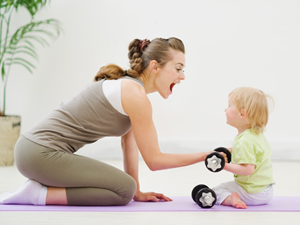Exercise and Diet While Breastfeeding
 As most new mothers soon find out, exercising can put a damper on your milk supply when breastfeeding. I experienced this myself when I was four months postpartum.
As most new mothers soon find out, exercising can put a damper on your milk supply when breastfeeding. I experienced this myself when I was four months postpartum.
When it comes to milk supply, there needs to be an adequate amount of calories that you consume daily to produce a good supply of milk. Think about all the energy your body uses just to produce milk! I’ve read that you can burn anywhere from 300-500 calories a day while breastfeeding (and I believe that to be true). Let alone keeping up with the new demands of motherhood, like changing diapers and feedings every three hours.
Six weeks after you deliver, your doctor should clear you to start exercising, as long as you didn’t have a strenuous delivery or a C-section. You’ll want to take it easy initially, especially if you weren’t too active during pregnancy. I was waiting tables up until I was exactly eight months pregnant, and it wasn’t easy. It did help me stay in shape, but my feet and legs would swell after standing for too long. And my back – forget it.
Tips for breastfeeding and exercise (6 weeks after delivery):
- As I mentioned above, breastfeeding alone can burn upwards of 500 calories in just one day. Add exercise to the mix and you’ll be back to your pre-baby weight in no time (I actually weigh less now than I did before I got pregnant). The first few months after you deliver is not the time to put yourself on a diet. Make sure you don’t go any lower than 1,500 calories while exercising and breastfeeding. A sure sign that you’re eating too little is your energy levels will decrease and your milk supply will be coming in less frequently.
- Pump or feed your baby one hour before you exercise. Exercising while full could cause embassasing leakage or chafing.
- If you’re planning on doing a high impact activity, like running or a fitness class, make sure to wear a support bra (or two). Your girls will be bigger, heavier and your nipples are going to be more sensitive. Breast pads are a good idea too, just in the event that you leak a little.
- Avoid support bras that are too tight as they could lead to plugged ducts. It’s recommended to change your support bra right after exercise and get into a nursing bra or top. Avoid underwire bras at all costs.
- Clean off your breasts with warm water after exercise to get rid of any salt residue. Don’t use soap, lotions or alcohol, which can dry out your nipples and cause cracking (been there, not fun). Plus the warm water help drop your milk supply, and it feels good too when you’re really swollen.
While exercise is being introduced, be sure to eat plenty of calories from whole, nutrient rich foods – don’t diet too hard!
Foods that help increase milk production include:
- Water, although technically not a food group, is the most essential aspect in ensuring you’ll have an adequate milk supply. Always have a water bottle handy, especially while exercising. I read a few forums online and from other new mothers experiences, they said that water intake was very important and noticed a difference in their milk supply when they didn’t drink enough. Aim for one gallon each day, if not more.
- Oatmeal is a fantastic food to both maintain and build your milk supply. It is also one of the best complex carbs you can have for breakfast.
- Garlic has been used by nursing mothers for centuries. You don’t need to go overboard, but adding in some fresh garlic to your diet could help tremendously with milk production.
- Carrots contain a good source of beta-carotene which is high demand when breastfeeding. Carrots are also a healthy, low calorie snack that will help lose some of your baby weight.
- Fennel, an herb used to aid in digestion and queasy stomachs, is full of phytoestrogens and is believed to be an excellent galactagogue (a food, herb or supplement that aids in milk supply or ejection).
- Cashews, almonds and macadamia nuts are all good sources of calories, healthy fats (good for brain development) and antioxidants. Opt for salt-free or low sodium versions.
- Green papaya (unripe papaya) is a traditional galactagogue in Asia. It can be steamed or stir fried on high heat until tender, or taken in tablet form. If you’re a fan of Thai food, order Som Tam which is a green papaya salad.
- Ginger is another widely used milk boosting food.
- Oils like olive oil, coconut oil, falxseed oil and sesame oil are known to help aid in milk production. Use in moderation even though they are an excellent source of calories and healthy fats.
I recommend training each body part once a week for 30 minutes and add in an additional 30 minutes of cardio afterwards. Try not to spend more than an hour in the gym, especially in the beginning as your body is adjusting. As the weeks go on, you can try incorporating more, like plyometrics, as long as your milk supply is still up. Always listen to your body, and if possible keep a food journal of everything you eat during the day. This could help you should your supply start to dwindle.
Congratulations and here’s to you and your baby’s health and happiness!
I hope this article helped you, but if you do have any more questions or concerns I’d be more than happy to help you and your baby 🙂 Email me anytime at ChristinasFitness@yahoo.com and follow me on my social media platforms at FB/ChristinasFitness and IG/ChristinasFitness.
